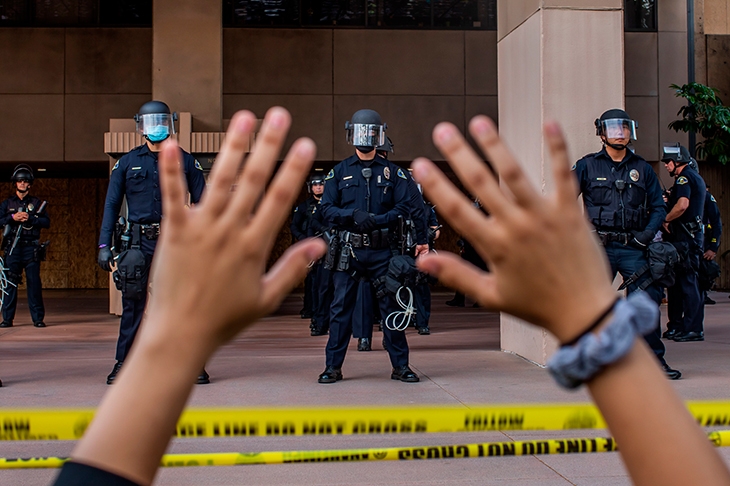America can often look, to outsiders, like a country of two warring tribes: the Trumpish anti-PC brigade vs the woke Twitterati. Such divisions certainly exist. Our broadcasters are party political and partisanship is deeply entrenched in America’s two-party system. It’s tempting to see the scenes in recent weeks as the continuation of tribal warfare by other means —but the truth is far more complicated.
America has the most militarised and aggressive police force in the western world. The country’s legacy of rapid expansion, combined with vast geography and open landscapes, engendered a sense of lawlessness early on — and a need to be protected from it. This has led to an implicit social contract: police need to be armed to match the criminals they’re dealing with. It’s the price for keeping the country safe. When the police bought vehicles that looked like tanks or dressed as if they were off to war, we didn’t ask questions. In theory, you knew it must go wrong sometimes. But what did ‘going wrong’ look like? Who did it affect? It was hard to imagine.
No longer. The ubiquity of smartphones means misdeeds are now filmed and shared instantly. We see America’s police officers treat low-level offenders and even innocent citizens with the same force and aggression you would expect to see used against the most violent criminals. Black Americans feel the overwhelming brunt of the brutality. When the system goes wrong, they suffer the most.
It’s a common trap to glance at cherry-picked statistics and say ‘nothing to see’. Black Americans are no more likely to be shot by police than they were five years ago. Most who were shot were carrying guns; 14 of the 55 unarmed Americans shot by police last year were black. But despite accounting for 13 per cent of the population, African–Americans make up more than a quarter of the 1,000 fatal police shootings that take place each year. An unarmed black man is four times more likely to be fatally shot than his white counterpart. Over the past two decades, nearly 30,000 Americans have been registered dead at hands of police — causes of death include Tasers, strongholds and head injury. There is now growing awareness of these tactics, and it’s forcing us to ask: are we okay with this?
George Floyd was killed by a cop’s knee shoved into his neck for nearly ten minutes. He died by asphyxiation, not a gunshot, so his death wouldn’t be registered on the fatal shooting list. But it registered with the nation, showing how out of hand police brutality is in America. It fits a trend. Earlier in lockdown Ahmaud Arbery, a 25-year-old black man, was shot dead by a former policeman and his son while out jogging in Georgia. There was Elijah Tufono, 14, punched and roughed up by a California cop for possession of a cigar. And Floyd is not the first time we’ve heard ‘I can’t breathe’ on camera — Eric Garner uttered the same words six years ago when police put him in a chokehold and strangled him to death for selling single cigarettes on the street.
After protests, Floyd’s killer was charged. So too were the cops who looked on. Their action and inaction exposes a culture, one that has been allowed to exist because not enough Americans thought it worth confronting. And of course far-left protestors have joined the marches, but to focus on them is fundamentally to misunderstand what’s happening. It’s not about the murder of one man, but of the countless black men Floyd’s death represents, and the warped social contract that has allowed it to happen.
The justice reforms of the 1980s and 1990s have had the unintended effect of worsening race relations. Bill Clinton’s war on drugs — using prison as its main tool — disproportionately puts black Americans behind bars. Drugs are used and sold equally by black and white Americans, but black Americans are six times more likely to be incarcerated for a drug offence. Meanwhile, the Supreme Court’s establishment of ‘qualified immunity’ for the police allows officers to only face punishment if their crime clearly infringes on an established, often technical, right. This has encouraged appalling excesses.
That’s why we find former presidents George W. Bush and Barack Obama calling for policy reform, and why former presidential candidate Mitt Romney was out on a march hosted by an openly left-wing campaign group. The left and right divide has broken down these past few weeks, driven by America’s collective memory of its history of racism. What England remembers as the Victorian era, Americans remember as a time of slavery and the Civil War. Jim Crow is in living memory, as our parents and grandparents joined Martin Luther King Jr to march on Washington. It’s fresh and raw – still – in a way that is unique to the nation.
The protests in Britain — as in America — have been used as cover for those with an agenda of violence and destruction. But most people marching will have done so in sympathy with America, and to highlight issues that also exist in the UK.
And there’s one key difference. In both countries, we have seen videos of people throwing themselves between protestors and police. But in the UK, protestors have been stepping in to protect the police from stones and glass bottles. To this American, it was a very moving sight that emphasised the differences between policing in my homeland and my adopted country. America is policed by force, while the UK is policed by consent — something worth holding on to.






Comments